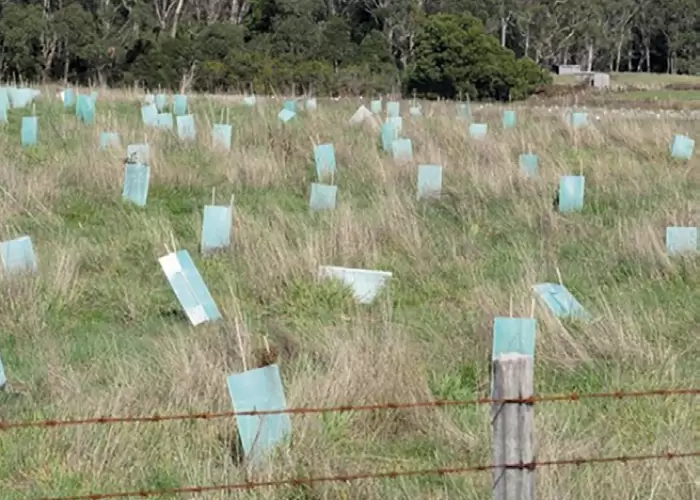Managing trees
Timely management means your plantation will be healthy and productive
Ongoing management and maintenance of your plantation is essential. Give your trees proper attention for a healthy and productive plantation.

Good management starts with a good understanding of your trees and their needs. Trees don't need the intensive management of annual crops, but you should still give your plantation the necessary attention for success. Activities differ from farm to farm, site to site, and even tree to tree. You can also adapt your approach over time.
Manage your plantation with regular checks and timely interventions.
Weeds
Weeds and grasses will aggressively compete with your trees for water, nutrients and light. This will limit your trees' growth and your plantation's productivity. Before planting, it's important to develop and carry out a weed control strategy to protect your investment.
There are two broad approaches to weed management:
- Non-chemical including burning, slashing, mulching and grazing
- Chemical including translocated or systemic chemicals, root-absorbed chemicals and germination inhibitors.
It's crucial to use the right chemical for the job and you must also follow the relevant legal regulations. Seek professional advice before starting work.
Did you know?
Grass competition is the number one cause of failure for farm plantations.
Find guidance and tools for developing a weed control strategy:



Pests and disease
Native and introduced pests and disease can severely damage or kill your trees. Protect your assets by regularly inspecting your plantation for signs. Look out for:
- Physical damage such as eaten leaves or damaged bark
- Discolouration such as yellowing foliage
- Black mould, insects, caterpillars or sticky covering on foliage
- Lump or bums on foliage or limbs
- Dead branches.
If more than 10% of a tree's foliage is affected, it’s essential that you investigate the cause and take necessary steps. This could include treating trees with insecticide, spraying plantations, or – if severe – cutting down and burning trees to reduce spread.
Find more information on pests and diseases, and how to manage them:
Farming Guides – Pests and disease The most common pests and diseases found on plantationsBrowsing
Wild mammals, introduced animals and livestock can all cause damage to growing trees. Before designing control measures, take steps to identify the issue and animal species. Common browsing mammals include:
- Brushtail possum
- Pademelons
- Bennett’s wallaby
- Rabbits and hares
- Deer.
Control methods for browsing include fencing, repellent, shooting, palatability and tree guards.
If native animals are causing damage, try non-lethal methods first. If they fail, check the laws and permit requirements before using methods such as trapping and shooting.
Find resources to help recognise and respond to browsing damage:
Farming Guides – Browsing damage to seedlings Fencing Shooting to Control Wallabies and PossumsPruning
Pruning is when branches are removed from a tree trunk to control how a tree grows. Large, straight, knot-free trees generally get highest prices at market, so pruning improves the quality and value of timber.
Pruning also removes dead, diseased, and injured parts of a tree. There are two main types of pruning:
- Form pruning to produce a straight trunk and control branch size
- Clearwood pruning to produce the maximum amount of knot-free wood.
It's crucial to prune trees on schedule. Pruning too early can reduce a tree's growth rate, but pruning too late can damage a tree's form.
Find information on the benefits of pruning and how-to practice guidance:
Form and clearwood pruning Farming Guides – PruningThinning
Thinning is removing trees from a plantation to reduce competition for light, water and nutrients.
Thinning a plantation means there are more resources for the remaining trees, which support their growth and value. There are two types of thinning:
- Commercial where trees are selectively thinned and sold to market
- Non-commercial where poorly formed or competing trees are thinned for waste.
You can do multiple thinnings over your plantation's lifecycle. Methods and equipment vary depending on which type of thinning you are planning. In commercial thinning, consider practicalities that can affect profitability, such as access and transportation.
Find guidance on thinning methods, tree selection and timing schedules:
Farm Guides: Thinning Thinning


Fire management
Fire is a land management tool that can protect trees, regenerate vegetation, reduce fuel load and manage weeds.
Fire management is a complex science. You should only conduct planned burns according to a robust fire management strategy. You will also need to get the necessary permits and approvals.
If you're thinking about using fire as a land management tool, seek professional support as a first step.
Find more information on planning and conducting burns on farms:
Planning a burn?
Free operational support and education are available for Tasmanian farmers through the Red Hot Tips Program, run by State Fire Management Control (SFMC).Red Hot Tips Indigenous land management
Cultural burning
Cultural burning, including cool burning, is an Indigenous land management tool. Burns are led or conducted by Aboriginal individuals or organisations to improve the health of, and connections to, Country.
Indigenous land managementNatural eucalypt regeneration
Natural regeneration is where trees are encouraged to grow back by themselves. Activities such as weed and browsing control, fire management and seed spacing help trees during the process.
Most eucalypt plantations in Tasmania are managed by harvesting, followed by replanting. But natural regeneration is becoming more common as a cost-effective management approach.
Managing coppice (multi-stemmed shoots that grow from cut stumps) is also used to regenerate eucalypt plantations.
Native regrowth forests
Tasmania’s native regrowth forests have a long history of active management to produce multiple benefits.

